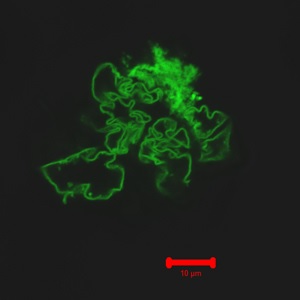 |
| Green fluorescent protein molecules linked into nanofibers for drug delivery applications--Courtesy of Carnegie Mellon |
Polymer nanomaterials are crucial for many types of drug delivery applications, offering the flexibility and durability needed to engineer specific shapes and sizes for particular delivery solutions. Now, at Carnegie Mellon, researchers have developed a new technique for creating self-assembling fibers for this purpose, taking a cue from the natural fibers in living cells.
The team used a green fluorescent protein, its molecules linked to one another to form fibers. But although these molecules do not normally link together, the scientists had to do some tinkering to get them to assemble in such a way. By adding PEO-dialkyne linkers to the proteins, they joined together to form long chains.
"We have demonstrated that, by adding flexible linkers to protein molecules, we can form completely new types of aggregates," study author Tomasz Kowalewski said in a statement. "These aggregates can act as a structural material to which you can attach different payloads, such as drugs. In nature, this protein isn't close to being a structural material."
Importantly, the linked GFP structures retained their fluorescence, which, according to a report from Carnegie Mellon, indicates that the molecules held on to their original shapes even when linked together. This is key for the structural integrity of the overall compound.
"Our protein-polymer system gives us an atomically precise, very well-defined nanoscale building object onto which we can attach different handles in very precisely defined positions," Kowalewski said. "It can be used in a way that wasn't ever intended by biology."
- here's the Carnegie Mellon report